Geospatial analysis of forest resources availability
for the reconstruction after Earthquake 2015
Him Lal SHRESTHA, Nawaraj
CHAPAGAIN,
Krishna Ram DHITAL, Sujan ADHIKARI, Nepal
1)
This paper was presented at the
SUMMARY
Government of Nepal had introduced community forestry program since 3
and half decades and achieved to hand over the patches of forests to
more than 18000 forest user groups. Almost, the forest in each VDCs are
hand over as community forests. The major activities implied in the CF
are protection and conservation of the forest to ensure the greenery and
the stock of the forest. The rest of the forest at community access is
the national forest governed by governmental authorities such as
Department of forest. The forest stocks are overwhelmingly high and
there is scope of getting forest products for the community basic
requirements. The recent devastating earthquake hit in Nepal put the
pressure on land by degrading the lands as well as damaging the local
infrastructure including private buildings, small houses, animal sheds.
This has increased the local demand of forest resources to reconstruct
the buildings. The current discussion are being increased to get
permission to cut the forest of Chure Environment Conservation Area
however that option is not feasible in terms of product delivery as well
as environmental perspective. Thus, the aim of this study is to assess
the resources available in the forests in locality taking the geospatial
approach as the method of analysis.
The study basically explored the resource available at local level
which has spatial distributions differently at different geographic
areas in Gorkha district where the epicenter lied. It will also see the
cost and environmental significance of the resource delivery based on
the transportation and other cost involved. This study tried to link the
devastation due to earthquake, demand generated on forest resources and
the resource availability in the locality. The geospatial approach has
been adopted to see the potential delivery of the resources in the
district. The analysis included the data available at different aspects
such as forest coverage, distribution of the community forestry
intervention in local administrative unit, prescription of district
level timber extraction in CFs and the transportation opportunity in the
district and vicinity villages.
The study concludes with the recommendation to the resource managers and
policy makers not to make the earthquake as a granted to cut the forest
trees somewhere from the distant forest stand. The local forest in the
vicinity can supply sufficient timber.
BACKGROUND
The federal democratic republic of Nepal is located in between
Tibetan (Chinese) and Indian plates and lies in a seismically active
region. According to world record Nepal is 11th most earthquake-prone
country. Historical data shows that first earthquake was recorded in
1255 AD in which King as well as one third population of Kathmandu
valley was killed due to the tremor of earthquake. Similarly, Nepal has
faced major shock in 1934 with 8.4magnitudes. Earthquakes have been
causing several casualties damage in 1980, 1988 and 2011 AD (GoN, 2015).
The recent tremor was felt on 25th April, 2015 firstly with the 7.6
magnitude and followed some major aftershocks on more than 6.0 magnitude
and more than 400 aftershocks of 4.0 magnitudes in total and 29
aftershocks in Gorkha. As the main epicenter of this episode of the
earthquake is Barpak village of Gorkha district,it is later known as the
“Gorkha Earthquake”. The hypocenter of this earthquake was reported at
the depth of approximately 8.2km (5.1 mile) from ground surface. This
shock cause more than 8856 human casualties loss from all over the
country with fully damaging 2673number of government buildings and
602257 numbers of private houses. Similarly partial damage by this shock
was in the number of government buildings and private houses was 3,757
and 285,099 respectively (GoN, 2015).
The occurrence of such earthquakes in Nepal caused great destruction
in human life as well as in physical structures. This main shock is
still followed by 400 numbers of aftershocks with local greater or equal
to 4 magnitude until 15th October 2015 (Nepal seismology center) with
the moving epicenters in neighboring districts Nuwakot, Rasuwa, Dhading,
Sindhupalchowk, Dolakha. Thus, heavy destruction of human and physical
infrastructure was on those districts.
Two villages of Gorkha, Barpark and Laprak have been totally
flattened out by devastating earthquake in April. While, people residing
in Barpak and some other VDCs have initiated the reconstruction of their
temporary houses and farm house by reusing available residue of timber,
stone plates and zinc plates and other materials provided by Government
and Non-government organizations as a relief materials. But many of
houses from Laprak and other remote VDCs are still hopeful from
government and non-governmental sectors for further help. On discussing
reconstruction of physical structures there are different modalities to
resume in its original state. One of them approved methodology by
peoples society is by using community forest timber and reusing residue
of initial state.
Nepal has been practicing forest areas for special task operation at
certain national emergency time. At the time of armed conflict period,
which was started from 1996 to 2006 AD in Nepal both rebel and army
group had used forest area for their specific purposes. Both of them ban
for local FUG on entering and harvesting forest products and used for
this for training operations, hiding purpose and barrack establishment.
After peace process establishment in 2006; 31 thousands of People’s
Liberation Army (PLA) of Communist Party Nepal (Maoist) was
reestablished by building cantonment at different 7 areas, which was the
land of national forest areas. Considering this approach and special law
enforced in Forest Act 1993, Chapter 2- rule no 16 advocates on loose
rule for government forest officers to collect and take out timber from
the forest area at any time for its sale and distribution to victims of
natural calamities.
AAccording to Government of Nepal, Department of Forest decided that
total 50 cft. timber will allocated for completely damaged private
buildings and 20 cft. timber will allocated for partial damage of
private buildings. Again in case of intuitional buildings 100 cft. will
allocated for complete and 40 cft timber will allocated for partial
damage. This analysis shows that there will total 7805560 cubic foot of
timber is essential for reconstructing total damages of physical
structures, which can also be calculated by following mathematic
relation.
Total Volume = Volume timber needs
for permanent damaged household *number of household+volume timber needs
for partially damaged household *number of houehold
The majorities of houses are made from mud-bonded and are of
construction of bricks or stone (CBS, 2011). Again most of the houses
damaged by earthquake seem on such damaging houses rather than Rod,
Cement and Concrete. These raw materials for immediate re-establishment
can be fulfilled from community forest products. Community forest is one
of the potential sources for natural ecosystem services viz. timber and
fuel wood and other by products etc. These ecosystem services are low
cost as well as easily available from proximate areas. Again spatial
determination of forest land use practices will highly crucial for
scientific analysis of harvesting natural ecosystem services according
to its potential. This analysis will further help on availability and
effective economic assessment related to other common analysis.
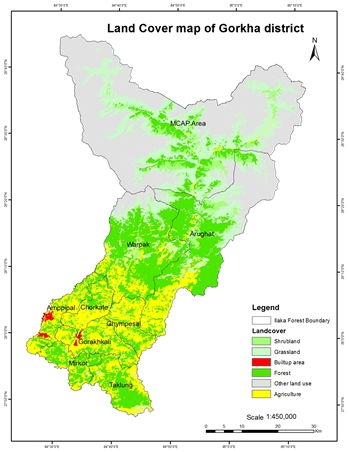
Figure 1 Forest Cover in Gorkha district (2010)
Table 1 Land cover statistics in Gorkha (2010)

To recover from current disaster analysis of living situation of the
people, reconstruction of the damaged structure and other parameters are
very crucial. Construction of damaged private and social infrastructures
require large amount of timber; which will directly affected by its
availability and accessibility from forest land and other land use
practices. So it is necessary to analyze the present growing stock of
timber, demand in terms of proximities. This paper tries to assess the
current scenario of the stock and demand ratio with respect to
reconstruction unit of timber from the point of view in different Ilaka
of Gorkha district’s forest. Which ultimately try to examine the recent
government decisions regarding the collection, sale and distribution of
timber from Chure range. This will be a challenging issue with
consideration of environmental degradation, due to fragile ecosystem of
Chure forest.
OBJECTIVES OF STUDY
Overall objective of this research is to assure availability and its
potentialities of Timber extraction and growing stock determination from
all community forest of Gorkha districts, its spatial distribution
analysis to mitigate local people in terms of timber demand for physical
structures re establishing.
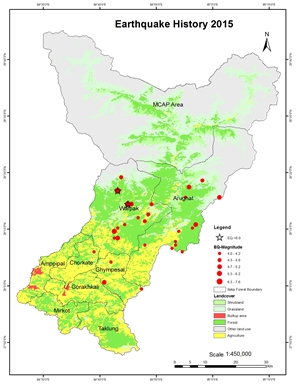
Figure 2 Aftershocks of Gorkha Earthquake in
Gorkha district
METHODS AND METHODOLOGY
Study area
Gorkha is one of the sixth districts from Gandaki Zone in Nepal’s
Western Development Region. This district seems like as ladder form,
which varies from geographical Mahabharat region to Alpine zone. It is
bordered by Dhading district (Budhi Gandaki river) in east; Tanahun,
Lamjung, Manang, (Chepe River) in west, Tibet of China in North and
Tanahun and Chitwan district in South. Gorkha district has an area of
3610 sq.km, which area is fourth biggest district among 75 district of
Nepal. Gorkha district varies from 228 meter to 2500 meter above mean
sea level. It occupies in area between 84027’ to 85058’ latitude to
26015’ to 28015’ longitude.
Gorkha is one of the high populated districts from Nepal with more than
271,000 populations. This is the district with first earthquake
epicenter occurred in April 25th 2015 and one of the worst-affected
districts among 14 district of Nepal. National record of government of
Nepal shows that, up to September last 449 no of people were killed from
this devastating disaster. The majority of houses from this district are
made by mud-bonded and constructed of bricks or stone (GoN, 2011). Wood
is the main sources of energy for cooking purposes in this district (CBS
2011).
Methods
This study was based on both secondary data collection from different
published and unpublished recent earthquake related articles by
different NGO, INGO’s, Cabinet decision of GoN, Forest data from
District forest office such as: Growing stock and Allowable cut,
potentiality of timber production at community forest of Gorkha district
and another was Spatial data relationship from forest land use of Gorkha
district by using Arc GIS tool.
Firstly, Gorkha district was divided into 8 Ilaka forests and one MCA
region. Ilaka may be a group of VDC/Municipality which is considered as
a basic unit provided by District Forest Office. Secondly,
geospatial analysis of all Ilaka forest was done by using Arc GIS 10.1
software. Now, The supply and demand of the timber were compared
according to its potential/capacity by reviewing accessibility of
physical infrastructures such as road terrain, slope, altitude, aspect,
labor potential etc. These data was further analyzed by comparing total
current timber demand by allowable cut, according to CF Operational
Plan. Once deficiency oftimber demand are further fulfilled by
considering either increasing in allowable cut or by considering as
certain duration timeline for infrastructure reconstruction in future
years./p>
Average demand of timber, allowable cut, average growing stock and
other relationships were analyzed through Microsoft tool, other spatial
relationship like demarcation, buffering, distance measurement were
analyzed by ARC GIS 10.
RRESULTS AND DISCUSSIONS
1. Ilaka Wise Household with shed damage and Governmental buildings
damage:
According to last census recorded by CBS Gorkha 2014, total household
recorded in Gorkha district is with 66506 numbers with 271061
populations. But, According to DAO Gorkha total no of households are
76647 out of which total 63863 households has taken relief fund as
primary compensation provided by Government of Nepal, after earthquake
on April 25 (DAO 2015).
Below table gives recent data with respect to household damage due to
earthquake in different Ilaka and in MCAP area. This table shows that
about 84 % of the infrastructures with in district get damaged by this
sock on April 25, which was calculated by subtracting from total
household and relief funds distributed for per household. Given table
also includes on private buildings as well as animal shed damaged
altogether, which are also key needs to be reconstruct soon. Again
Institutional infrastructure noted on governmental buildings present
within the district.
Table 2: Ilaka Wise Household and Damage.

Source: DAO, 2015
Above data shows that out of total 76,647 households present in
overall district, total private buildings was destructed in 84,491
numbers, along with 550 in numbers of governmental building. These
buildings were destructed in both fully and partially in condition.
Almost 72060 numbers of complete damages was occurred in private
buildings with 12431 numbers of partial damages. Similarly 486 numbers
of Governmental buildings were completely get damaged and 64 buildings
were again partially damaged.
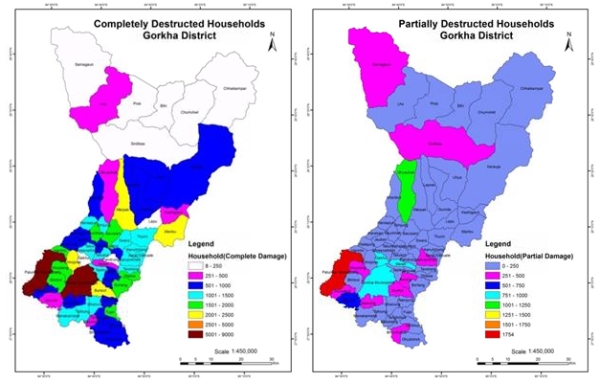
Figure 3 VDC wise Building damage by Earthquake
in Gorkha
2. Present Satus of Community forest in district
According to LRMP (1979), out of 361,470 Ha total area of the
district 24.45% of area is covered by different types of forests i.e
88393 Ha. Manaslu conservation area covers all total 46.07% (166300 Ha.)
of total area of Gorkha district. on calculating vegetation status all
over the district, in Gorkha altogether there are 464 CFUGs presented
with in district by covering 23364.33 ha land, government managed forest
area is covered by 27752.23 ha area, and total 900.84 ha area is covered
with leasehold forest, 30.79 ha land is covered with Religious Forest
and 42.65 ha land is covered with Private forest. (DFO FYP 2071-2076).
Following data presented in table is calculated according to analysis
of 473 CF handed over to the community users up to 2015. These forest
areas are further divided in 8 Ilaka forest by District Forest Office
Gorkha for management perspective. Table 3 Growing Stock and Annual Allowable cut of
Community Forests

Source: District Forest Office Gorkha 2015.
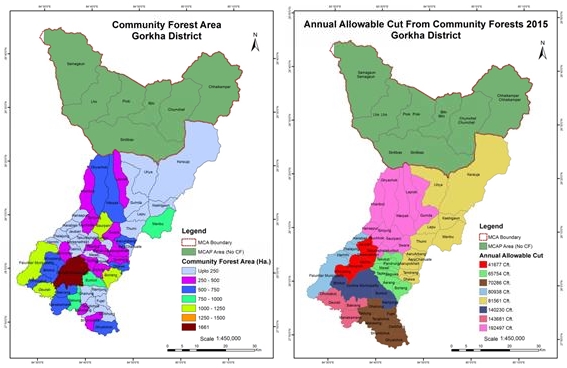
Figure 4 Community Forest areas and allowable cut
in Gorkha district
AbAbove table shows that total community forest has ability of
producing 81149709.2 cft timber per year in volume as growing stock.
According to the Community forest Operational Guideline CFUG can extract
timber up to 75% of annual growth from forest at good condition,
similarly 60 % of extraction from medium forest and 40% of extraction
from poor forest (Community Forestry Inventory Guideline 2061). But now
only 50% of annual growth of timber is considered as allowable cut for
Gorkha district by analyzing over all forest condition of the district.
So, CFUG operational plans only permit for 816625.76 cft timber
extraction per year from community forest of Gorkha district.
1 . Demand of timber for reconstruction
Timer is considered as major constituent for reconstruction of
buildings in remote areas buildings. So we consider as separate unit of
timber for partial and complete damage of houses as well partial and
complete damage of institutional buildings. In considering this
Government of Nepal, Ministry of Forest and Soil Conservation,
Department of Forest has prolonged a operational plan to reconstruct
such physical structures, in this operational plan department has
mentioned as 50 cft for complete damages houses and 20 cft for partial
damages houses. Similarly for institutional buildings it has considered
as 100cft for complete damages and 40 cft for partial damages. But
according toinformation provided from District Forest Office Gorkha,
Forest office can only provide 30 cft timbers for complete damage
buildings and 20 cft timbers for partial damages buildings.
Scenario 1: This scenario 1st speaks on distribution of timber for
earthquake damaged private and governmental buildings and it’s overcome
of demand in certain period of time, according to decision of Department
of Forest, Kathmandu Nepal. p>
According to the decision made by of Department of Forest, average
timber demand distribution on completely damaged buildings will
preferred for 50 cft and 20 cft for partial damaged buildings. Again 100
cft will allocated for completely damaged governmental buildings and 40
cft timber for partially damaged governmental buildings.
Table 4 Timber demand according to the Department
direction
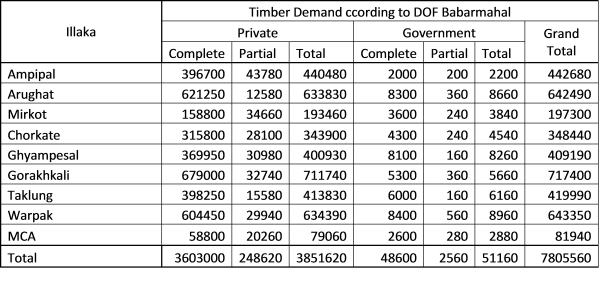
Scenario 2: This scenario 2nd speaks on distribution of timber for
earthquake damaged private and governmental buildings and it’s overcome
of demand in certain period of time, according to decision of District
Forest Office Gorkha, Nepal.
Table 5 Timber demand according to the DFO,
Gorkha
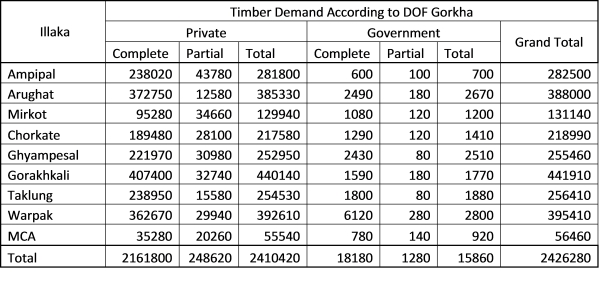
AcAccording to the decision made by of District Forest Office, average
timber demand distribution on completely damaged private buildings will
preferred for 30 cft and 20 cft for partial damaged buildings. Similar
30 cft timber will be allocated for completely damaged governmental
buildings and 20 cft timber for partially damaged governmental
buildings.
2. Total timber deficit
Due to high demand of the timber in current year, each VDC of all
Ilakas cannot get fulfill in this year except in Mirkot Ilaka Forest. So
on calculating current timber demand, 3 times of allowable cut is
recently needed for reconstruction of damaged buildings. Though
reconstruction is desired in short period of time, it is also a long
term process too; so completion of all damaged buildings may takes few
more years. A realistic timeframe for the implementation of the
earthquake recovery program is at least five to seven years (GoN, 2015).
Gradually deficit will be recovered as the reconstruction time frame
extends. In next 3 years the following deficit timber can be extracted
from community forests to fulfill over all timber demand. On depending
on Community Forest, no other sources are needed to fulfill the local
demand if the reconstruction process is extended for few years.
Timber deficit 2015 is calculated by subtracting the Annual allowable
cut from total timber needed for reconstruction. Timber deficit in 2016,
2017 and 2018 is calculated by subtracting the timber deficit from their
respective previous year. Table 6 Situation of timber demand and supply in
Gorkha district
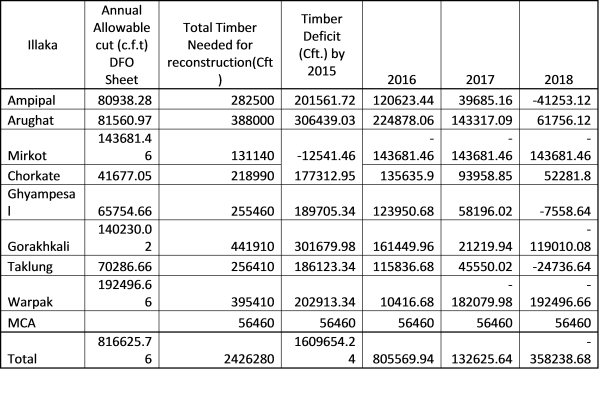
Table 7 Deficit and Surplus status till Five Years
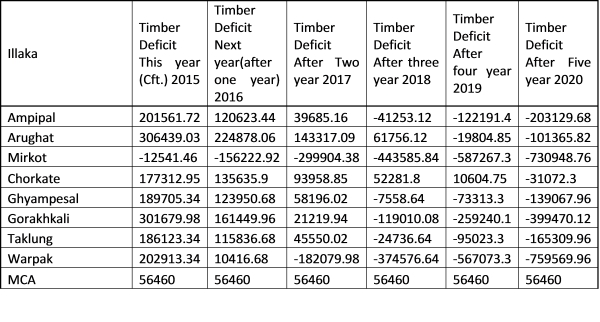
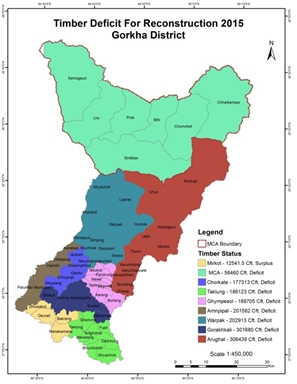
Figure 5 Timber deficit and surplus
map |
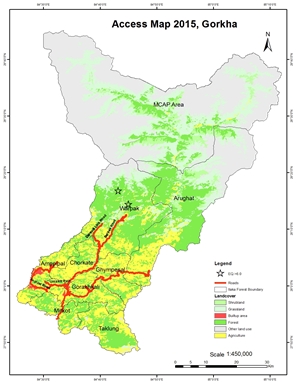
Figure 6 Access map of Gorkha distict |
The demand on Manaslu conservation can be fulfilled from Arughat and
warpakillakas only. As Arughat has its own huge demand, supply from
warpak is essential.
Mirkot has its surplus from this year so it can be mobilized to
adjoining illakas like Taklung, Anpipal, and Gorakhkali. Ampipal Ilaka
can fulfill their demand by 2018, Arughat Illaka by 2019, Chorkate by
2020, Ghympesol,Gorakhkali and Taklung, by 2018,warpak by 2017with
surplus 41253 cft,19804 cft, 143681 cft, 31072cft, 7558cft, 119010 cft,
24736 cft, 192496 cft respectively. In case of Mirkot Illaka, their
demand this year is less than annual allowable cut so they can fulfill
demand this year with surplus timber 12541.5 cft. And in Manaslu
Conservation Area 56460 cft of timber must be fulfilled from other
Illaka because we cannot harvest from this areas forest.
CONCLUSION
In conclusion, the results from this study shows that the need of the
timber supply for the reconstruction of buildings caused by earthquake
2015 can be fulfilled from the local sources of timber such as National
forest, community forests and private forests in Gorkha. The enabling
environment for the timber harvest and the transportation needed to be
analyzed further. The sustainable harvest of the timber from the forest
areas in the district can fullfil the local demand of the timber in
Gorkha district within three years which ultimately the sustain the
forest areas in the district as well as it will protect the
environmentally important wood lots such as Chure region, if we have
devised the proper plan of timber harvest linking with the nature of
local demand of the timber viz. Urban people and rural people may have
different need of the timber, people may not need entire demand of
timber at the same time. The timber need may be categorized as of 3
months, 6 months, 1 year, 2 years and 3 years from the earthquake
devastation. The other important management consideration should be the
use of previous woods from the old building.
ACKNOWLEGDEMENT
Authors would like to acknowledge eG-Tech Pvt. Ltd. for necessary
resources to conduct this study. We also want to acknowledge District
Forest Office and District Administration Office, Gorkha for making
necessary field data available.
REFERENCES
- CBS (2014). District profile, Gorkha.
- DFO (2014). Five Year Forest Sector Plan of Gorkha District. pp
116.
- GoN (2015a). Nepal Earthquake 2015: Post Disaster Needs
Assessment. Vol A: key Findings. pp 134.
- GoN (2015b). Nepal Earthquake 2015: Post Disaster Needs
Assessment. Vol B: Sectors reports. pp 312.
- Paudel, G., Bishowokarma.,Paudel, N.S., (2015). Government
decision on relaxing Chure Timber Supply to address post-earthquake
reconstruction Demand: A sensible decision or just a gesture? pp
4.
- Hashemi, M., Alesheikh, A.A., (2011). A GIS-based earthquake
damage assessment and settlement methodology. Soil Dynamics and
Earthquake Engineering, V 31(11), pp1607-1617.
- Liu, J.G., Mason, P.J., Yu, E., Wu, M.C., Tang, C., Huang, R.,
Liu, H., (2012). GIS modeling of earthquake damage zones using
satellite remote sensing and DEM data. Geomorphology, V
139-140(2012), 518-535.
- Hassanzadeh, R., Nedovic-Budic, Z., Razavi, A.A., Norouzzadeh,
M., Hodhodkian, H., (2013). Interactive approach for GIS-based
earthquake scenario development and resource estimation (Karmania
hazard model). Computers and Geosciences, V 51(2013), pp 324-338.
- Bhattacharya, S., Hyodo, M., Goda, K., Tazoh, T., Taylor, C.A.,
(2011). Liquefaction of soil in the Tyoko Bay area from the 2011
Tohoku (Japan) earthquake. Soil Dynamics and Earthquake Engineering,
V 31(11), pp 1618-1628.
- Dong, Yanfang., Li, Qi., Dou, Aixia., Wang, Xiaoqing., (2011).
Extracting damages caused by the 2008 Ms 8.0 Wenchuan earthquake
from SAR remote sensing data. Journal of Asian Earth Sciences, V
40(4), pp 907-914.
- Erdik, M., Sesetyan, K., Demircioglu, M.B., Hancilar, U.,
Zulfikar., (2011). Rapid earthquake loss assessment after damaging
earthquakes. Soil Dynamics and Earthquake Engineering, V 31(2), pp
247-266.
- Liu, Huan., Cui, Ximin., Yuan, D., Wang, Z., Jin, J., Wang, M.,
(2011). Study of Earthquake isaster Population Risk Based on GIS.
Procedia Enviromental Sciences, V 11(2011), pp 1084-1091.
BIOGRAPHICAL NOTES
Dr. Him Lal Shrestha holds a PhD degree from Kathmandu University
(KU) and is currently working with Ministry of Population and
Environment, as a Natural Ecosystem Restoration Specialist under EBA
South Project, Nepal. His current research focuses on the geospatial
approach in Forestry and Natural Resource Management, Geospatial
approach for REDD and MRV, land use land cover mapping and analysis,
Geodatabase management and Web mapping.
Mr. Nawaraj Chapagain is currently a PhD Scholar in Kathmandu
University. He has a close interest on the local requirement of the
resource for the reconstruction of the earth quake victims.
Mr. Krishna Ram Dhital holds a Bachelor degree in forestry from
Tribhuvan University, Nepal. Currently, he is working with eG-Tech Pvt.
Ltd. as a Research Officer.
Mr. Sujan Adhikari holds a Bachelor degree in forestry from Tribhuvan
University, Nepal. Currently, he is working with eG-Tech Pvt. Ltd. as a
Research Officer.
CONTACTS
Him Lal Shrestha
Mountain Ecosystem Restoration Specialist
EBA South Project – Nepal
Ministry of Population and Environment
Email: hlshrestha@gmail.com
Nawaraj Chapagain
PhD Scholar
Department of Environment Science and Engineering
Kathmandu University
Email: ncchapagain@msn.com
Krishna Ram Dhital
Research Officer
eG-Tech Pvt. Ltd.
Email:
krishnaramdhital070@gmail.com
Sujan Raj Adhikari
Research Officer
eG-Tech Pvt. Ltd.Email:
write2sujan@gmail.com
|







































